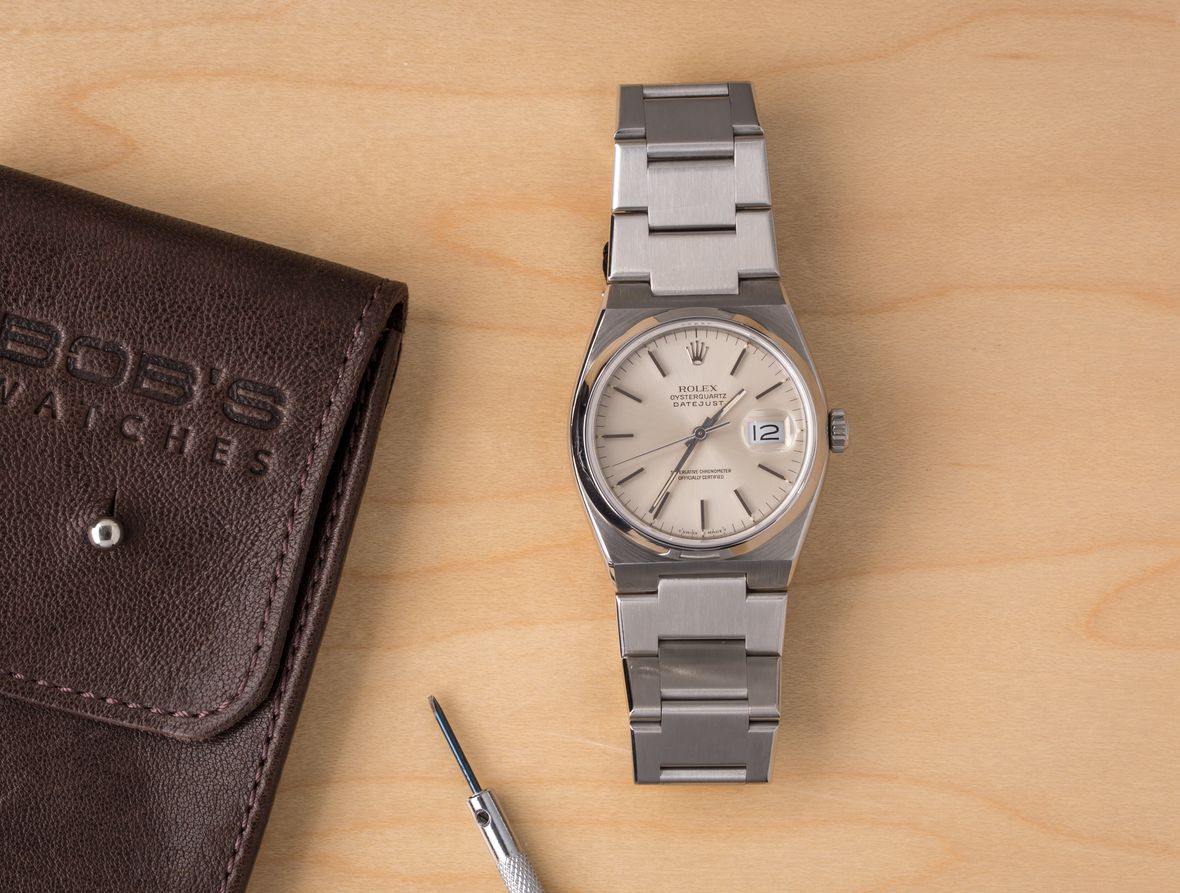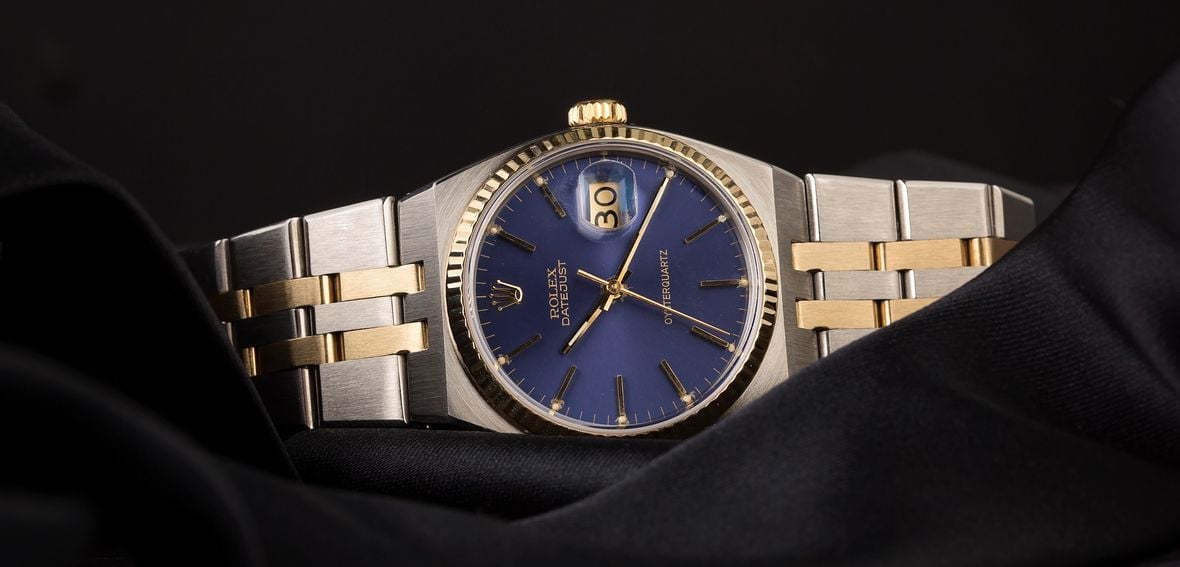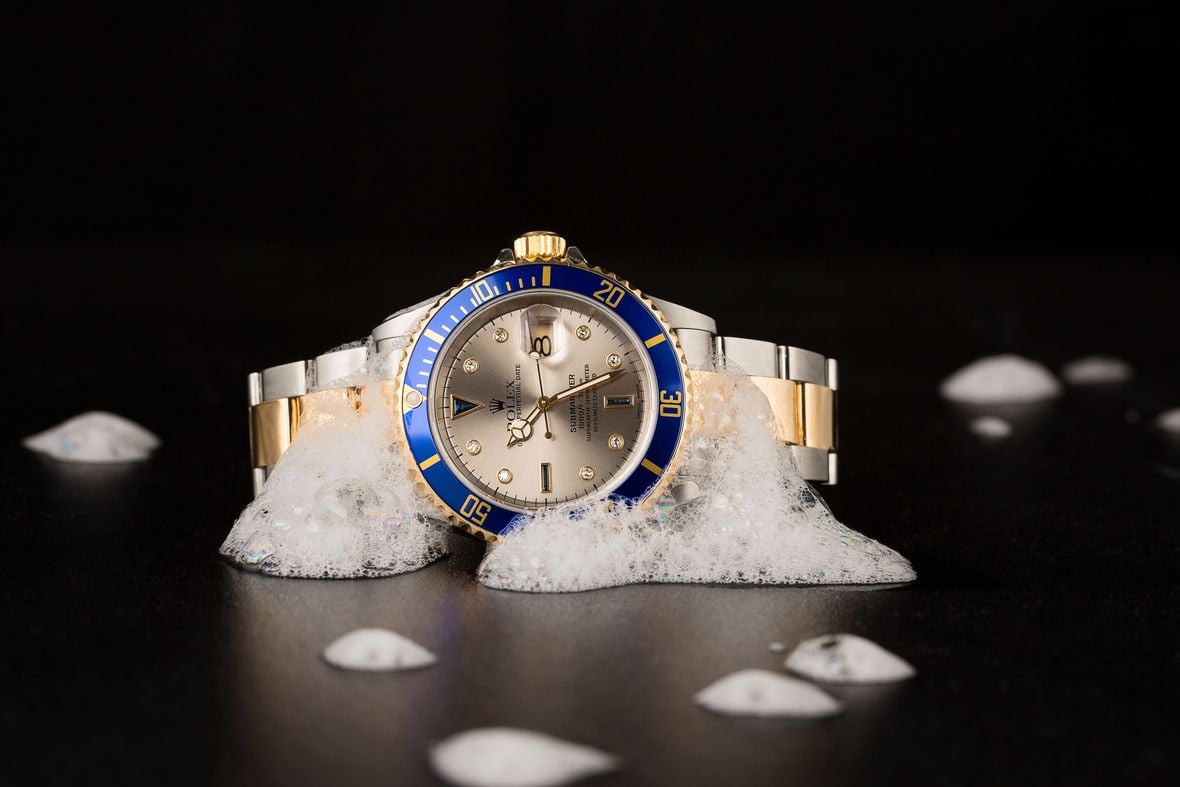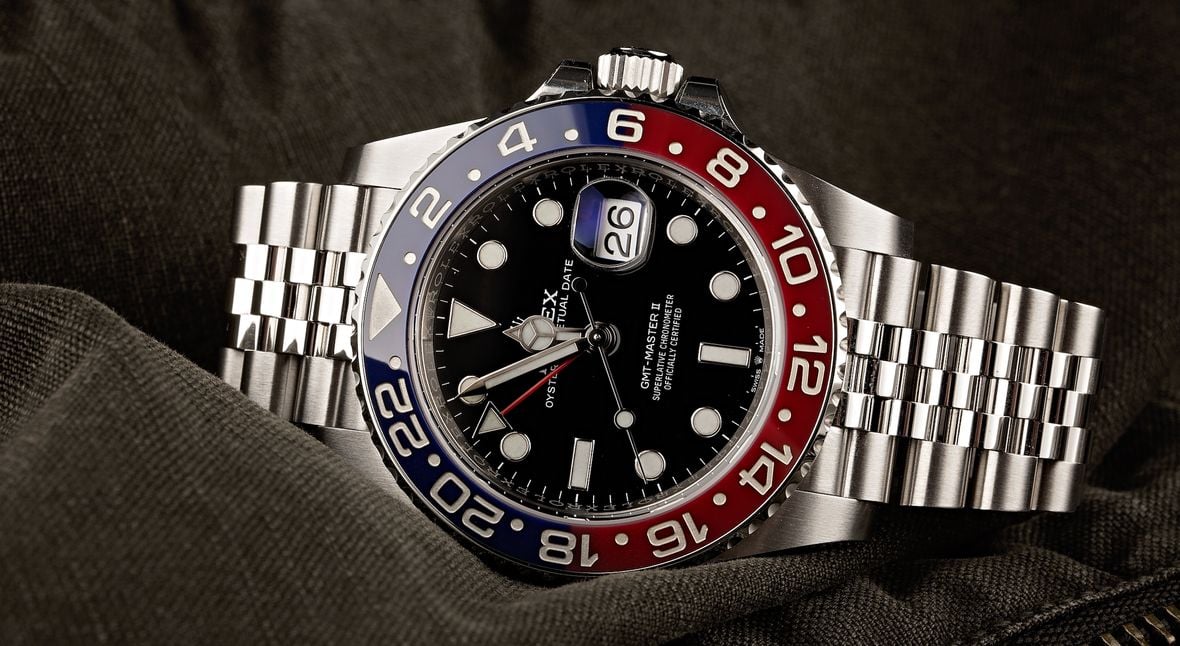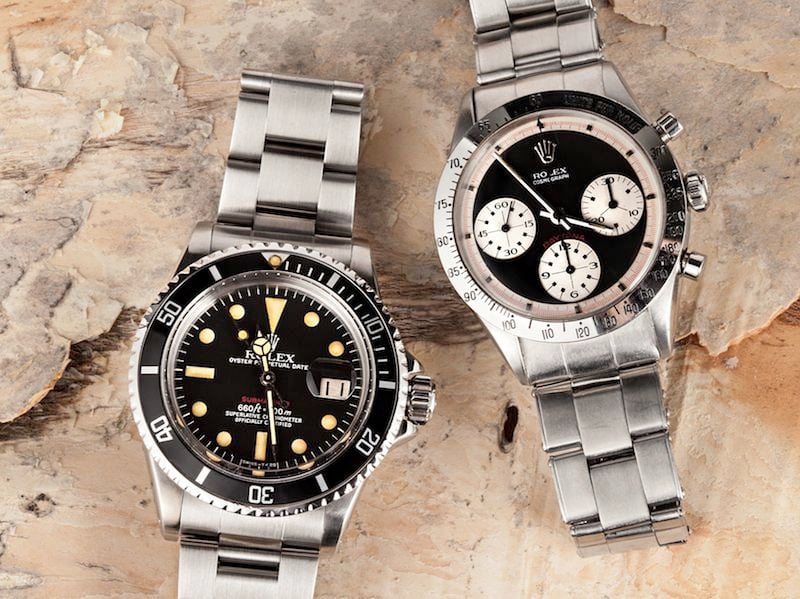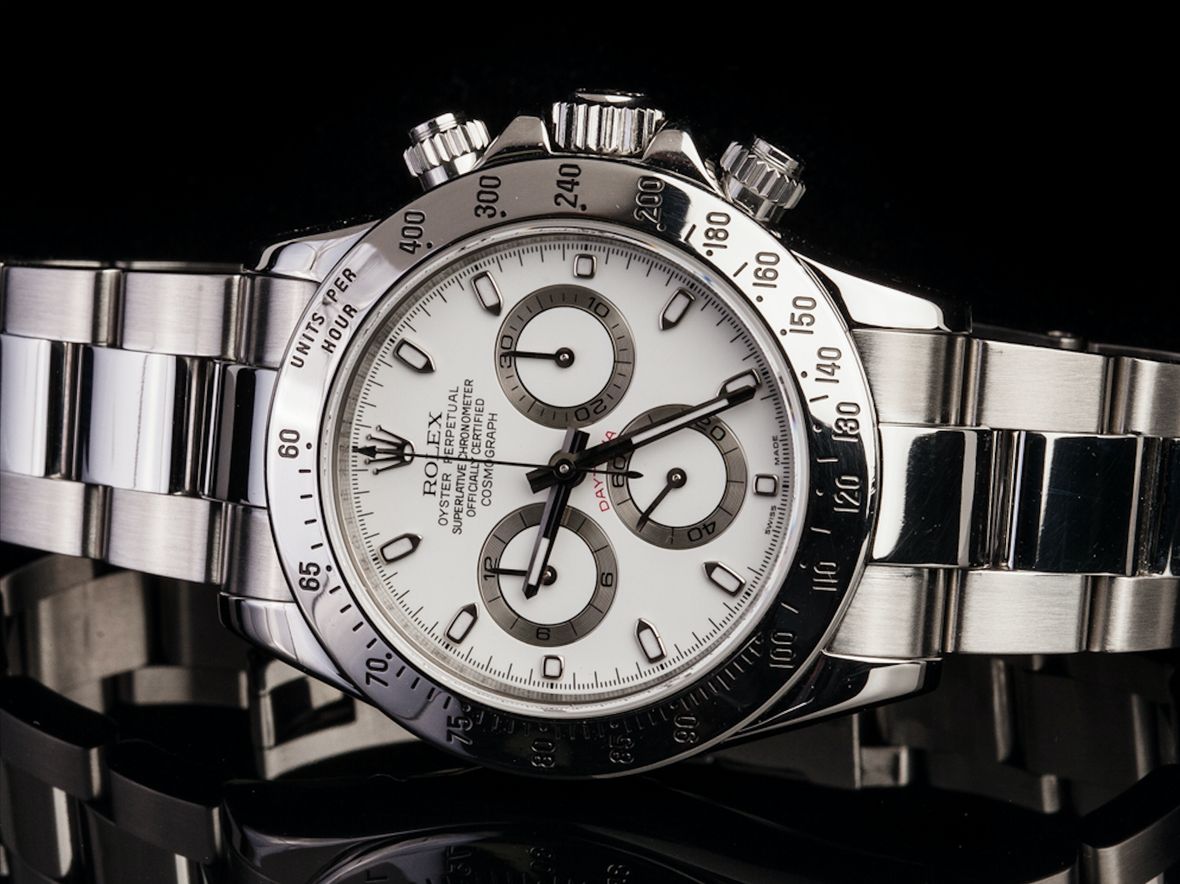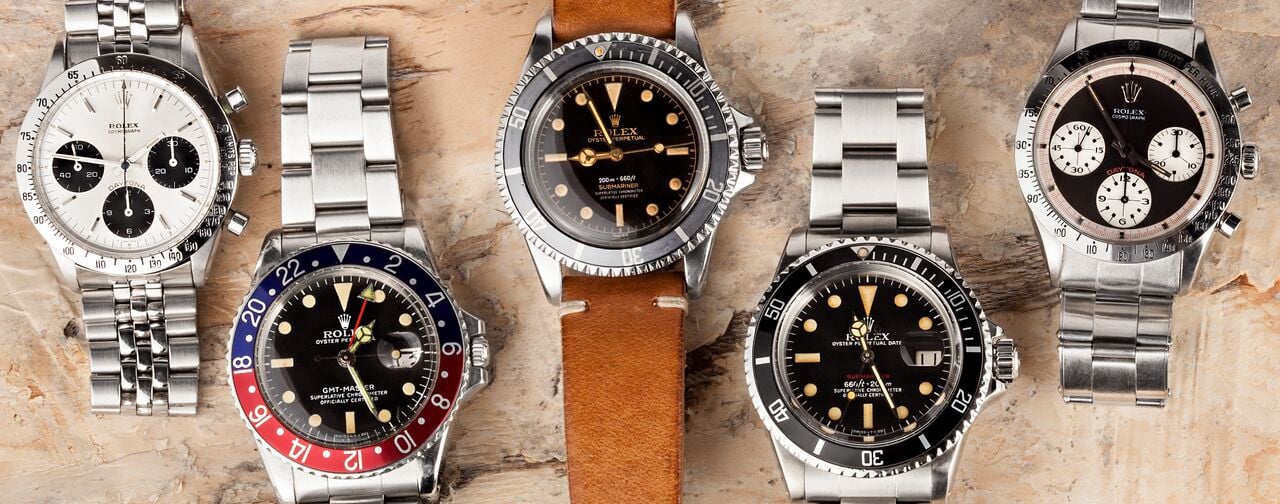Yes, even Rolex joined the quartz movement. Rolex may be known for its robust and reliable mechanical calibers, yet there was a time when the Swiss watchmaking company got on board with the quartz craze, and there are actually quartz Rolex watches. Throughout the 1960s, Japanese firm Seiko and a consortium of Swiss watch brands were competing to create the world’s first quartz wristwatch. Just like the automatic movement that came before, and the keyless winding mechanism before that, electronic timekeeping and in particular quartz calibers, were poised to set off another watchmaking revolution – and both nations were determined to be the leaders. This sentiment often gets lost in today’s narrative about quartz watches as it’s too easy to write them off as cheap timepieces that are not worth a second thought.
However, quartz calibers were the darling tech of the 1960s and 1970s and big players in the watch business wanted a piece of that pie. When Seiko unveiled the Astron in December 1969 as the world’s first quartz wristwatch, it marked the beginning of the bitter battle that’s now described as either the Quartz Revolution or the Quartz Crisis, depending on if you were on the winning or losing side. But before the advent of quartz movements decimated most of the Swiss watchmaking industry, numerous high-end Swiss watch brands – including Rolex – fought back with an arsenal of luxury quartz watches. We take a closer look at the development and evolution of the Rolex Oysterquartz and reveal some surprising facts about this overlooked collection and why it is one of the best quartz watches on the pre-owned market.
The Precursor To The Oysterquartz Was The Rolex Date 5100
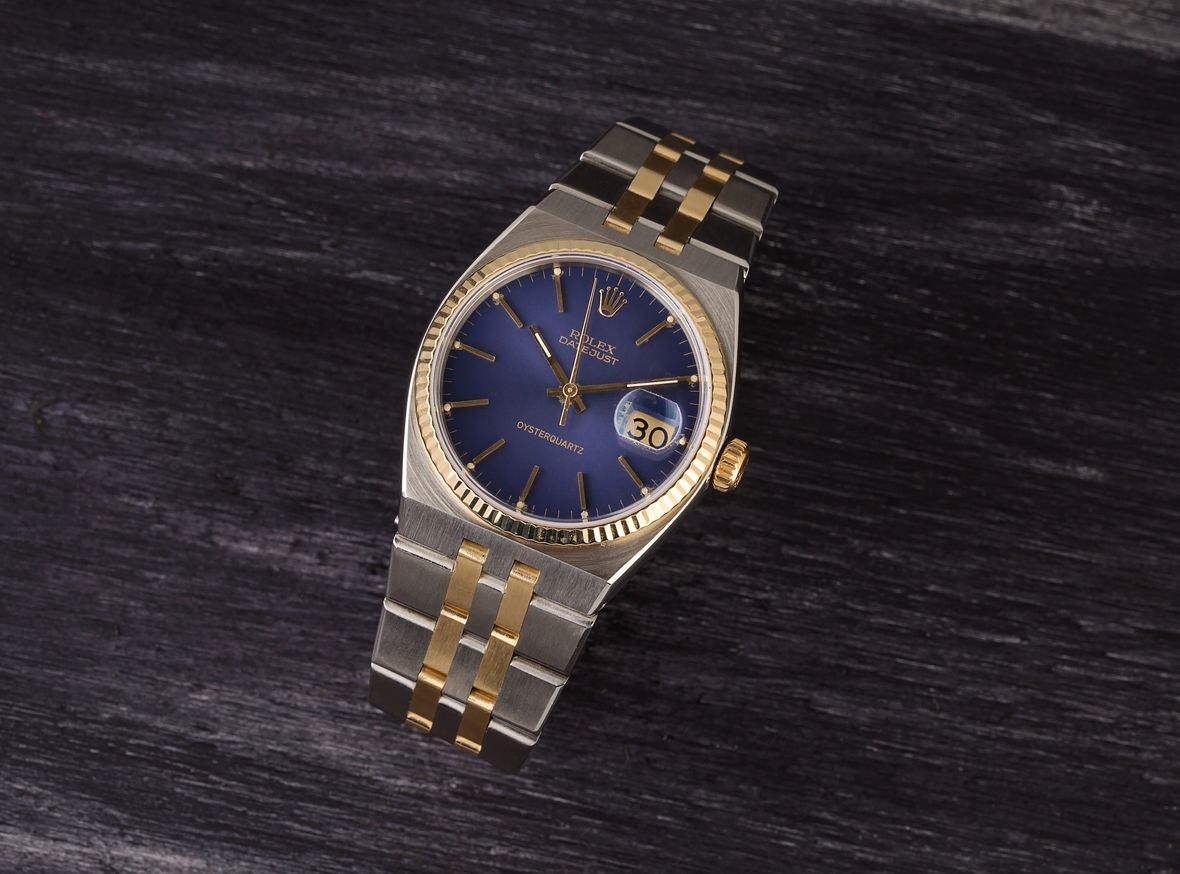
Quartz Rolex Watches
The first Rolex quartz watch was the limited-series Date 5100, powered by the Beta 21 movement. The development of the Beta 21 quartz caliber was the result of more than 20 Swiss watch brands uniting to form the Centre Electronique Horloger (CEH). The CEH’s mission was to create Swiss-made quartz movements to rival those that were made by other countries. The Beta 21 made its debut in 1969 (following the Beta-1 and Beta-2) and around 6,000 Beta-21 quartz calibers were made. Models like the Omega Electroquartz, IWC Da Vinci, Patek Philippe 3578, and Rolex Date 5100 all ran on the Beta-21 movement.
Released in 1970, it was originally thought that Rolex produced 1,000 pieces of the Date ref. 5100. However, since each watch is individually numbered and there have been some examples found on the secondary market numbered higher than 1,000, some theorize that there may have been two batches of one thousand pieces made. Regardless of the exact number, the Date 5100 apparently sold out quickly and many collectors assert that the entire batch was pre-sold before production even started.
Not only was the quartz movement inside the watch a first for Rolex, but the design of the Date 5100 was also unique. Fashioned entirely from 18k yellow gold, the Date 5100 featured a large (around 39mm) and thick angular case to accommodate the large Beta-21 movement, a fluted bezel, and an integrated three-link bracelet with wide center links. This was also the first Rolex watch to have a sapphire crystal, and Rolex later produced white gold versions of the reference 5100. If this design looks similar to the Audemars Piguet Royal Oak and Patek Philippe Nautilus that’s probably because, according to respected Rolex scholar James Dowling, Gerald Genta designed the Rolex Date 5100.
Despite the initial success of the Date 5100 (now affectionately known as the “Rolex Texan”) and its Beta-21 movement, fiercely independent Rolex did not think that it was in their best interest to offer watches that were equipped with the same movements as so many other companies. Therefore, Rolex ceased to be a part of the CEH and began the development of its own in-house quartz movement.
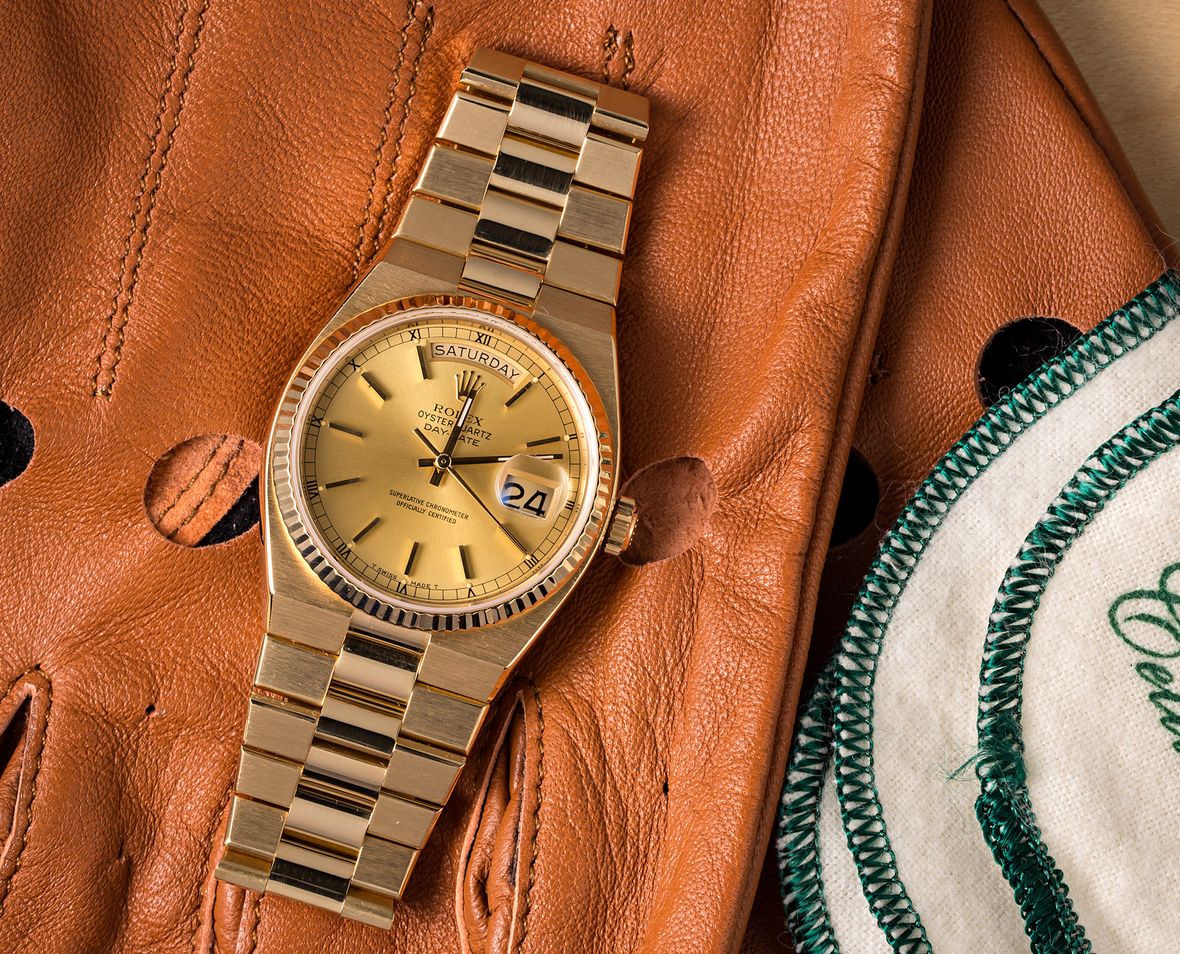
It Took Five Years To Complete The Oysterquartz Movements
Beginning in 1972, Rolex took five years to conceptualize, design, develop, and test its in-house quartz movements. In 1977 the brand introduced the 5035 quartz caliber for the Oysterquartz Datejust and the 5055 quartz caliber for the Oysterquartz Date-Date models. The Rolex Oysterquartz movements included 11 jewels and a 32khz oscillator. To maintain superior accuracy, Rolex recognized the need for a higher frequency oscillator than the Beta-21 to offset temperature effects so the oscillators of the Oysterquartz movements were four times faster than those of Beta-21. These in-house quartz calibers were hailed as modern marvels when launched and they offered superior accuracy to any of Rolex’s mechanical movements at the time. Additionally, both calibers offered quickset calendar functionality, as well as hacking seconds.
It’s interesting to note that the earliest examples of the Caliber 5035 were not sent to COSC for certification. As a result, Oysterquartz Datejust models made during this period do not have the “Superlative Chronometer Officially Certified” text on the dial. Towards the end of the decade, the Caliber 5035 was sent to COSC along with a small modification: the quartz crystal was changed into a tuning fork shape. Consequently, Oysterquartz Datejust references made from about 1979 onwards include the SCOC designation on the dial. The non-COSC Caliber 5035 movements are known as Mark I while the COSC-certified Caliber 5035 movements are referred to as Mark II movements.
On the other hand, Caliber 5055 was COSC-certified from the start; therefore, all Oysterquartz Day-Date references have the accompanying “Superlative Chronometer Officially Certified” label on the dial.
– Rolex Caliber 5055 – Oysterquartz Day-Date
– Rolex Caliber 5035 – Oysterquartz Datejust
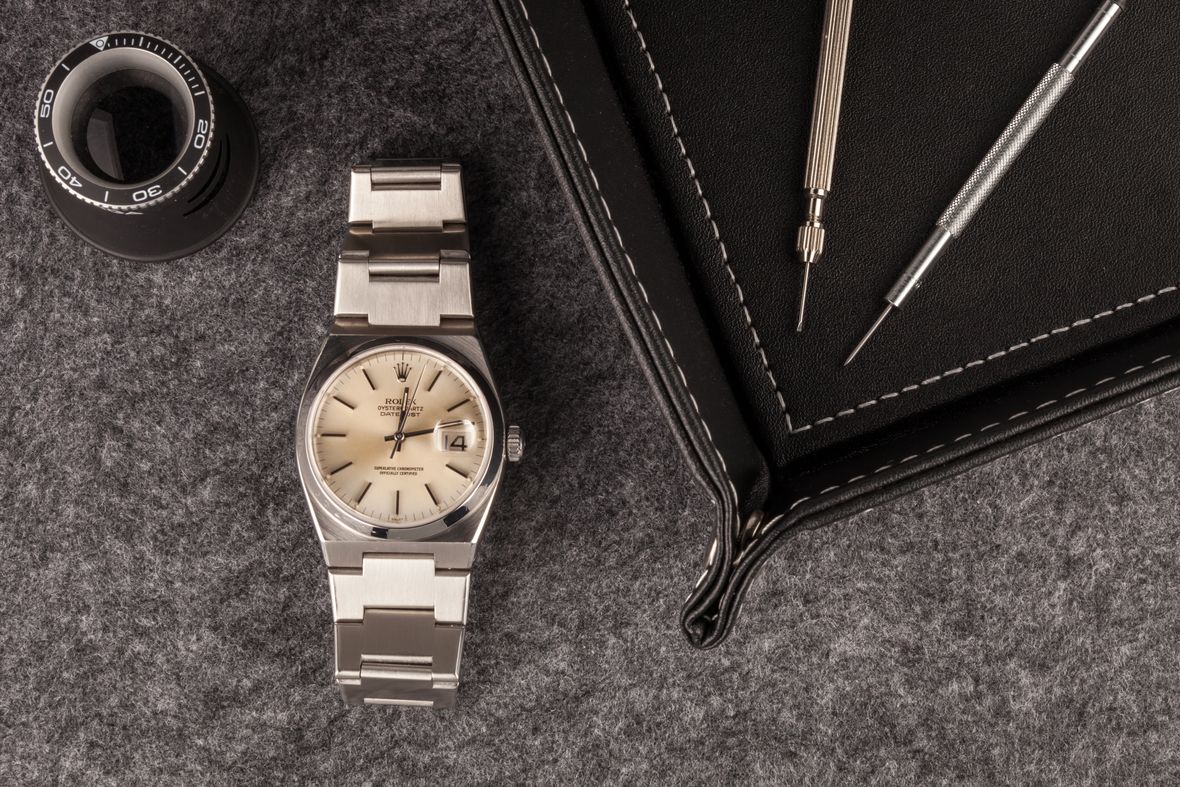
The Rolex Oysterquartz Was In Production For 25 Years
Rolex manufactured the Oysterquartz collection from 1977 until the early 2000s. During that time, Rolex made an assortment of Oysterquartz references, divided into Oysterquartz Datejust and Oysterquartz Day-Date lines. Like their mechanical counterparts, Rolex Oysterquartz watches sported 36mm Oyster cases that were available in a variety of materials. However, the shape of the Oysterquartz is much more angular than the classically round automatic versions and the cases are fitted with integrated bracelets – a timepiece aesthetic that was on-trend in the seventies.
The references 17000, 17013, and 19018 were the first Rolex Oysterquartz models that appeared in the brand’s catalog in 1977.
Rolex Oysterquartz Timeline
– 1977: Oysterquartz debut
– 2001: The last year Rolex applied for COSC certifications for quartz movements
– 2002: Steel Oysterquartz models no longer appeared in Rolex catalogs
– 2004: All Oysterquartz models disappear from Rolex catalogs
Rolex Oysterquartz Datejust Watches
– Oysterquartz Datejust 17000: steel case, smooth steel bezel, steel integrated Oyster bracelet
– Oysterquartz Datejust 17013: steel case with yellow gold crown, yellow gold fluted bezel, two-tone integrated Jubilee bracelet
– Oysterquartz Datejust 17014: steel case, white gold fluted bezel, steel integrated Jubilee bracelet
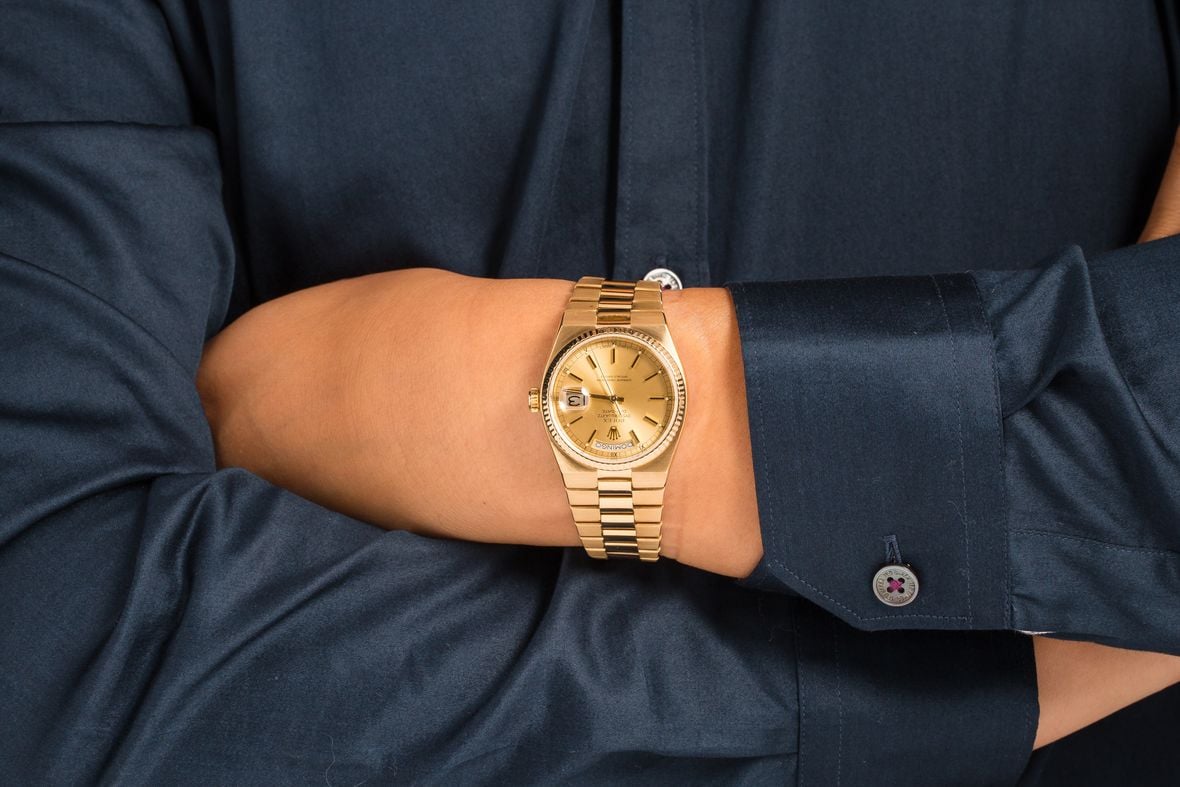
Rolex Oysterquartz Day-Date Watches
– Oysterquartz Day-Date 19018: yellow gold case, yellow gold fluted bezel, yellow gold integrated President bracelet
– Oysterquartz Day-Date 19019: white gold case, white gold fluted bezel, white gold integrated President bracelet
– Oysterquartz Day-Date 19028: yellow gold case, yellow gold pyramid bezel, yellow gold integrated President bracelet with pyramid center links
– Oysterquartz Day-Date 19038: yellow gold case, yellow gold pyramid bezel with 12 diamonds, yellow gold integrated President bracelet with pyramid center links
– Oysterquartz Day-Date 19048: yellow gold case, diamond-set bezel, yellow gold integrated President bracelet
– Oysterquartz Day-Date 19049: white gold case, diamond-set bezel, white gold integrated President bracelet
– Oysterquartz Day-Date 19058: yellow gold case, baguette-cut gem-set (either diamonds, rubies, or sapphires) bezel, yellow gold integrated President bracelet
– Oysterquartz Day-Date 19068: yellow gold case, diamond-set bezel, yellow gold integrated President bracelet with pyramid center links
– Oysterquartz Day-Date 19078: yellow gold case, rainbow gem-set bezel, yellow gold integrated President bracelet
– Oysterquartz Day-Date 19148: yellow gold case, diamond-set bezel, yellow gold integrated President bracelet with diamond-set center links
– Oysterquartz Day-Date 19168: yellow gold case, baguette-cut gem-set (either diamonds, rubies, or sapphires) bezel, yellow gold integrated President bracelet set with gems
– Oysterquartz Day-Date 19188: yellow gold case, diamond and ruby-set bezel, yellow gold integrated President bracelet with diamond-set center links
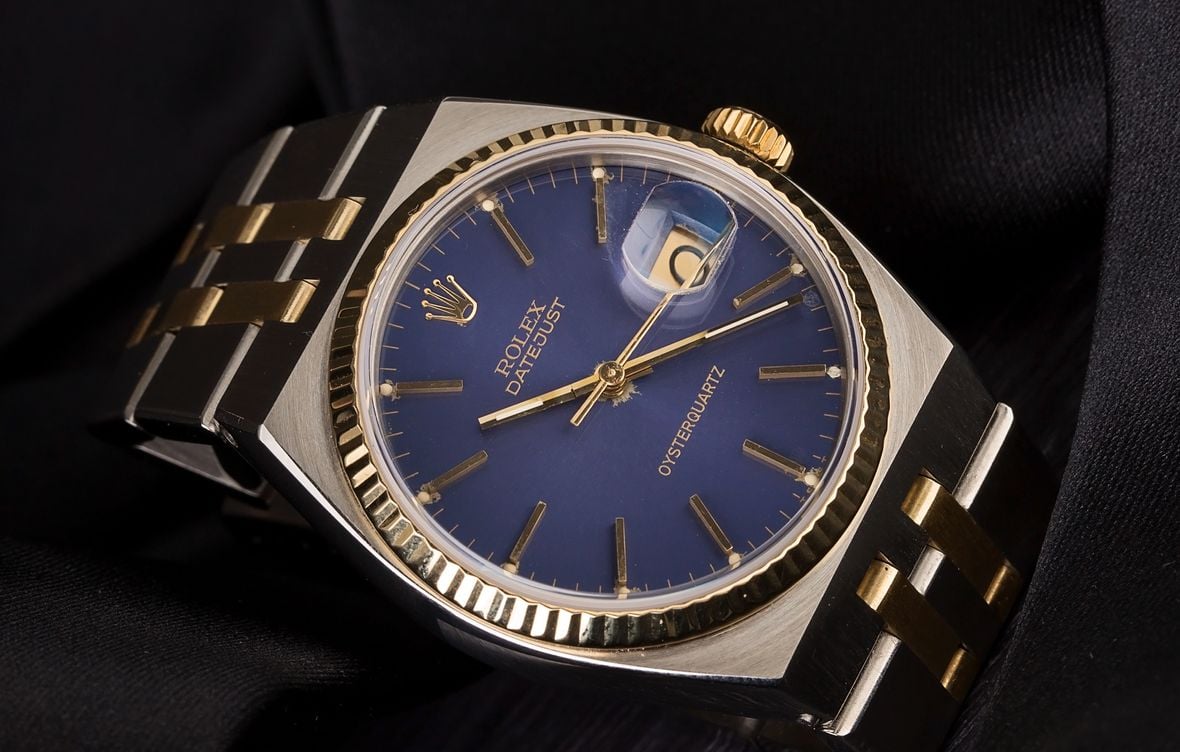
Less Than 25,000 Oysterquartz Watches Were Ever Produced
Although Rolex produced the Oysterquartz for about 25 years, it’s estimated that fewer than 25,000 Oysterquartz models were ever created. In the realm of Rolex manufacturing, that is an incredibly low number. Remember, Rolex now makes over a million watches per year, so the fact that there are less than a total of 25,000 Oysterquartz watches makes them relatively rare Rolex models to own.
2001 was the final year that Rolex applied for certification from COSC for its quartz movements and select Oysterquartz models remained in the brand’s catalog until 2003. The most common pre-owned Rolex Oysterquartz models available on the secondary market are the Datejust variants followed by the yellow gold Day-Date ref. 19018.
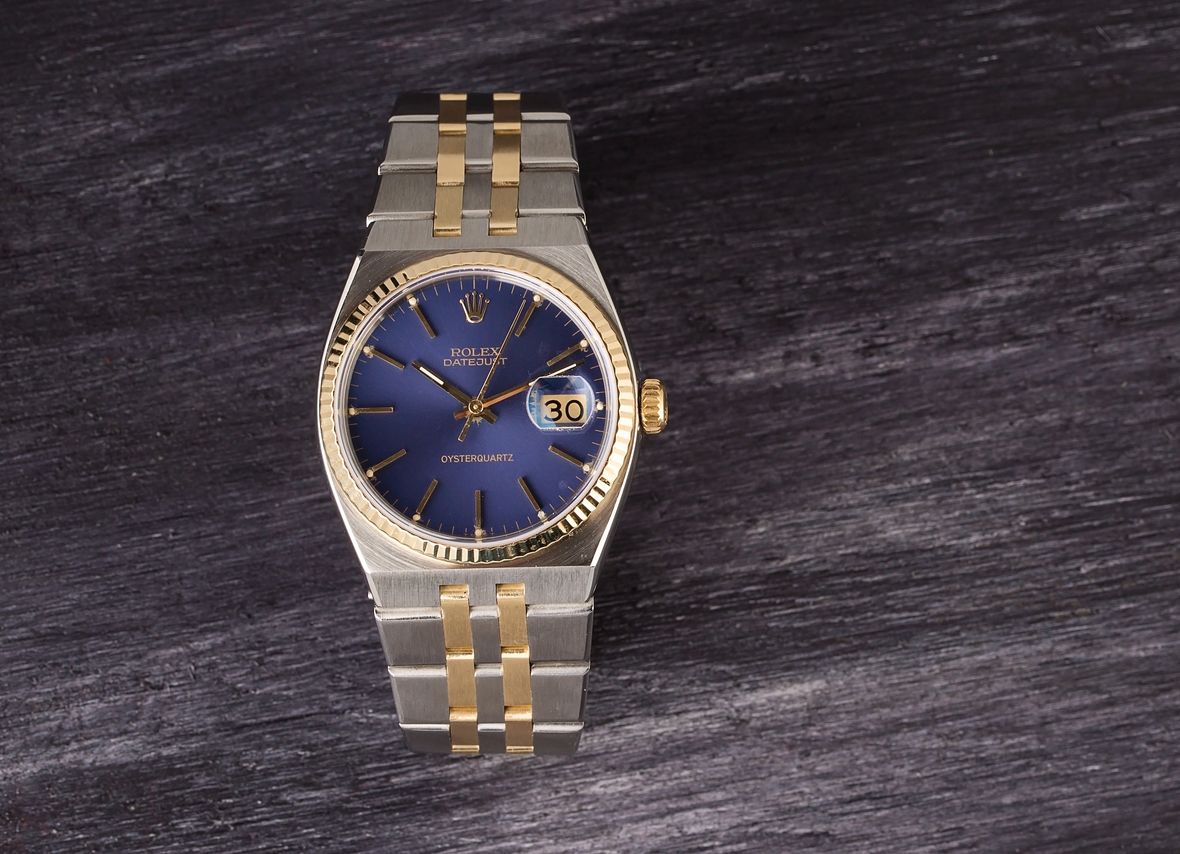
The Oysterquartz’s Signature Case and Bracelet Designs Were Used On Mechanical Models Too
Though the angular cases and integrated bracelets are defining design traits of the Oysterquartz, they are not exclusive to these Rolex quartz watches. In fact, a few years before the launch of the Oysterquartz, Rolex had already used these cases and bracelets with two other references.
While Rolex waited for the development of its in-house quartz calibers to finalize, the manufacturer already had the 36mm angular cases ready and waiting. So rather than letting these distinctive cases gather dust, Rolex paired them with the automatic Caliber 1575 movement. This resulted in the 1975 introduction of the Rolex Date 1530 and the Rolex Datejust 1630 – three years prior to the release of the Oysterquartz. The Date 1530 and the Datejust 1630 were short-lived references since Rolex discontinued them in 1977 to make way for the Oysterquartz watches, but you will find Rolex Datejust and Date watches that look like Oysterquartz models but are actually powered by automatic mechanical movements.
– Date 1530: steel case, smooth steel bezel, steel integrated Oyster bracelet
– Datejust 1630: steel case with yellow gold winding crown, fluted yellow gold bezel, two-tone integrated Jubilee bracelet
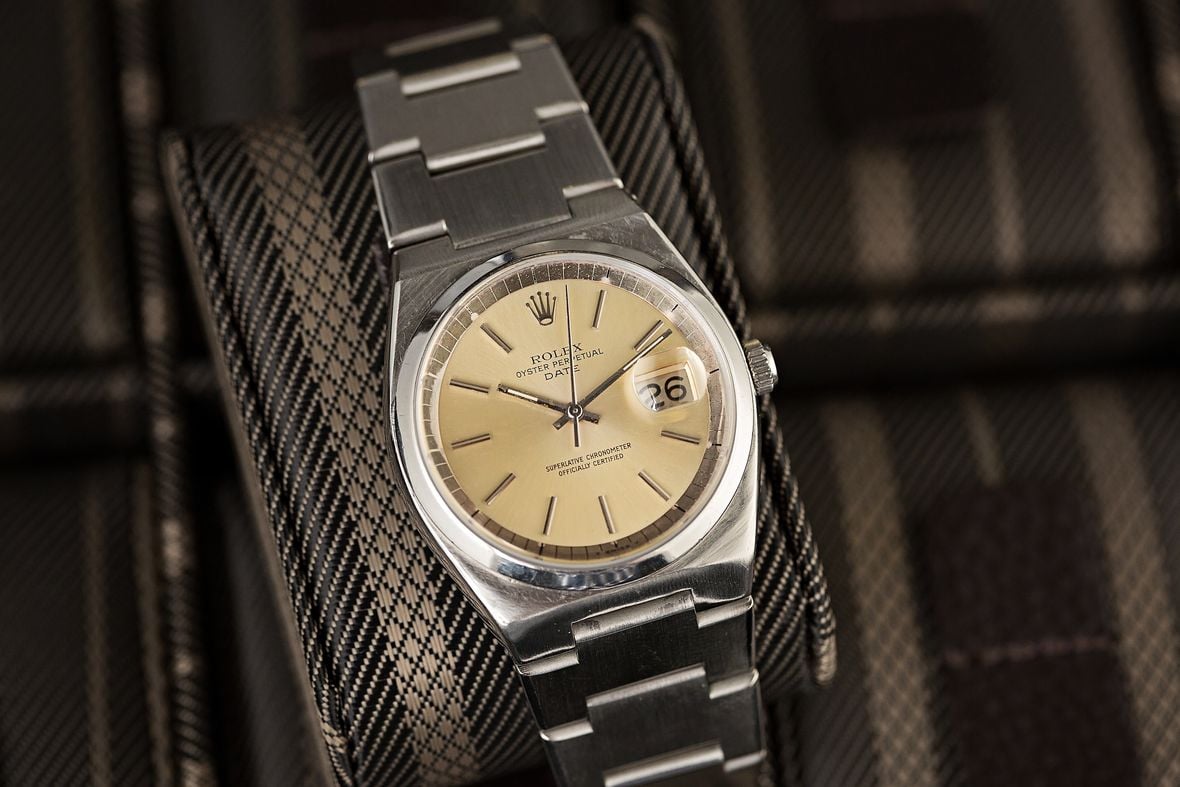
Rolex Had Plans For Oysterquartz Perpetual Calendar Watches
In the 1980s, Rolex began working on the next generation of the Oysterquartz movements. In 1987, Rolex filed a patent for a quartz perpetual calendar movement that could be programmed via the winding crown. Rolex made the Caliber 5355 for the Perpetual Calendar Day-Date and the Caliber 5335 for the Perpetual Calendar Datejust, and the brand even created a few prototypes of these perpetual-calendar Datejust and Rolex Day-Date watches. However, these Oysterquartz Perpetual Calendar models never made it to production, and most prototypes (it’s estimated that 11 prototypes were made) were ultimately disposed of or destroyed.
With that in mind, there have been a few examples that have managed to surface at auction. For instance, in 2004, an auction house had to withdraw one from a sale after Rolex filed a civil lawsuit claiming that the watch was stolen property (Rolex lost the suit). Furthermore, a steel Rolex Oysterquartz Perpetual Calendar prototype with a white gold bezel sold for over $250,000 at an Antiquorum auction in 2020. While these mega-rare Oysterquartz watches are out there, you aren’t likely to encounter one out in the wild.
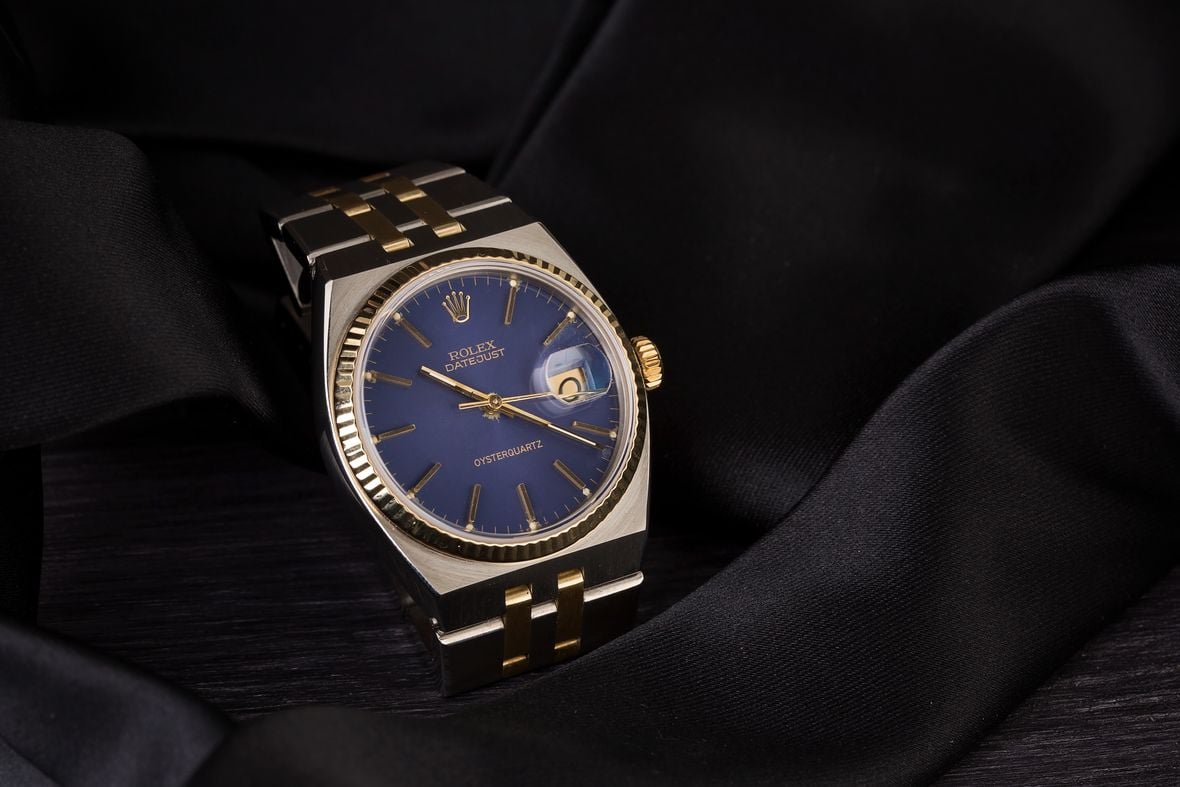
Is The Oysterquartz Due For A Revival?
Collectors and enthusiasts have long overlooked the Oysterquartz, preferring to give attention to Rolex watches with mechanical movements instead. However, like any other industry, the watch business has seen its fair share of trends come, go, and then come back again. If you look closely at what other watch brands are doing, you’ll note that there seems to be a growing interest in quartz watches. From the Q Timex Reissue smash hit to the surprisingly refreshing Cartier SolarBeat Must Tank line to cult-favorites from Autodromo, a few watchmakers are here to remind you that quartz movements shouldn’t always be brushed off to the side – after all, they are more precise, more durable, and ultimately more practical than mechanical movements.
This brings us back to the Rolex Oysterquartz.
The Oysterquartz represents an intriguing piece of Rolex history encased in one of the brand’s coolest-looking designs. The watch is still quite undervalued in the pre-owned market when compared to mechanical equivalents – yet, like most vintage and retro Rolex watches, prices for Oysterquartz watches are on the rise. The audible ticking of the Oysterquartz may have some people questioning if it’s a genuine Rolex but for those in the know, that may just be the sound of a soon-to-be collector’s item you wished you had given more attention to in the past.
